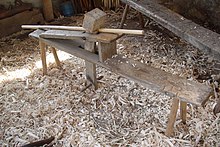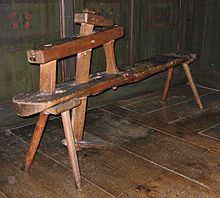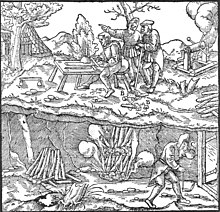Shaving horse
Typical usage of the shaving horse is to create a round profile along a square piece, such as for a chair leg or to prepare a workpiece for the pole lathe.
[2][3][4] The shavehorse provides a rapid and sturdy clamp, which allows the operator to use their legs and upper body weight as additional "power" for work.
Skilled operators can produce very fine results with a drawknife and shavehorse, requiring minimal lathe finishing.
Straddling a shave horse while carelessly using any dangerous power tool, such as a circular saw, may result in the operator suffering serious bodily injury.
Shave-horses are commonly workshop-made by their user and entirely wooden, though modern screws, washers, metal sleeves and threaded bolts with locking nuts are a very welcome and practical innovation, allowing re-tightening or capability to be knocked-down as necessary.
"[6] Mike Dunbar was widely criticised for this commentary and indeed in the original blog post where it was written, he turned off the 'comments' option to minimise this.




